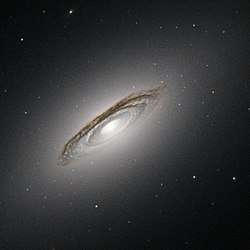NGC 6861
NGC 6861 is a lenticular galaxy located in the constellation Telescopium. It is the second-brightest object in the constellation. Unlike most lenticular galaxies, which tend to be mostly devoid of both gas and dust, NGC 6861 exhibits a thick obscuring ring of dust around the nucleus where star formation is occurring. The galaxy was discovered by Scottish astronomer James Dunlop, in 1826.[3] NGC 6861 is interacting with NGC 6868, and it is predicted that they will eventually merge.[4]
| NGC 6861 | |
|---|---|
 NGC 6861 | |
| Observation data (J2000 epoch) | |
| Constellation | Telescopium[1] |
| Right ascension | 20h 07m 19.48s[2] |
| Declination | −48° 22′ 12.8″[2] |
| Redshift | 0.009437[2] |
| Apparent magnitude (V) | 11.0[1] |
| Characteristics | |
| Type | SA0^-(s):[2] |
| Apparent size (V) | 3′ × 2′[1] |
| Other designations | |
| IC 4949[1] | |
References
- "NGC 6861". dso-browser.com. Retrieved 1 February 2015.
- "NED results for object NGC 6861". ned.ipac.caltech.edu. Retrieved 1 February 2015.
- "Hubble Views 'Third Kind' of Galaxy". nasa.gov. Retrieved 31 January 2015.
- Machacek, M. E.; O'Sullivan, E.; Randall, S. W.; Jones, C.; Forman, W. R. "THE MYSTERIOUS MERGER OF NGC 6868 AND NGC 6861 IN THE TELESCOPIUM GROUP". http://iopscience.iop.org. Retrieved 31 January 2015. External link in
|website=(help)
This article is issued from Wikipedia. The text is licensed under Creative Commons - Attribution - Sharealike. Additional terms may apply for the media files.